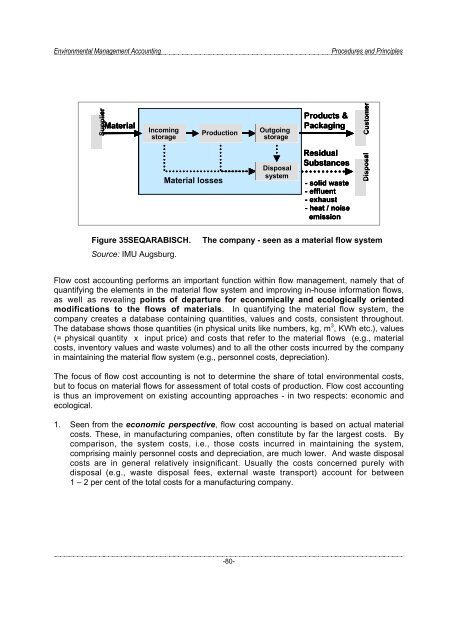Environmental Management Accounting Procedures and Principles
Environmental Management Accounting Procedures and Principles
Environmental Management Accounting Procedures and Principles
Create successful ePaper yourself
Turn your PDF publications into a flip-book with our unique Google optimized e-Paper software.
<strong>Environmental</strong> <strong>Management</strong> <strong>Accounting</strong><br />
<strong>Procedures</strong> <strong>and</strong> <strong>Principles</strong><br />
Supplier<br />
Material<br />
Incoming<br />
Production<br />
Outgoing<br />
storage<br />
storage<br />
Products &<br />
Packaging<br />
Customer<br />
Material losses<br />
Disposal<br />
system<br />
Residual<br />
Substances<br />
- solid waste<br />
- effluent<br />
- exhaust<br />
- heat / noise<br />
emission<br />
Disposal<br />
Figure 35SEQARABISCH.<br />
Source: IMU Augsburg.<br />
The company - seen as a material flow system<br />
Flow cost accounting performs an important function within flow management, namely that of<br />
quantifying the elements in the material flow system <strong>and</strong> improving in-house information flows,<br />
as well as revealing points of departure for economically <strong>and</strong> ecologically oriented<br />
modifications to the flows of materials. In quantifying the material flow system, the<br />
company creates a database containing quantities, values <strong>and</strong> costs, consistent throughout.<br />
The database shows those quantities (in physical units like numbers, kg, m 3 , KWh etc.), values<br />
(= physical quantity x input price) <strong>and</strong> costs that refer to the material flows (e.g., material<br />
costs, inventory values <strong>and</strong> waste volumes) <strong>and</strong> to all the other costs incurred by the company<br />
in maintaining the material flow system (e.g., personnel costs, depreciation).<br />
The focus of flow cost accounting is not to determine the share of total environmental costs,<br />
but to focus on material flows for assessment of total costs of production. Flow cost accounting<br />
is thus an improvement on existing accounting approaches - in two respects: economic <strong>and</strong><br />
ecological.<br />
1. Seen from the economic perspective, flow cost accounting is based on actual material<br />
costs. These, in manufacturing companies, often constitute by far the largest costs. By<br />
comparison, the system costs, i.e., those costs incurred in maintaining the system,<br />
comprising mainly personnel costs <strong>and</strong> depreciation, are much lower. And waste disposal<br />
costs are in general relatively insignificant. Usually the costs concerned purely with<br />
disposal (e.g., waste disposal fees, external waste transport) account for between<br />
1 – 2 per cent of the total costs for a manufacturing company.<br />
-80-




